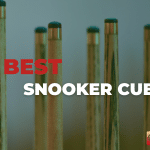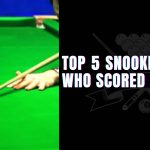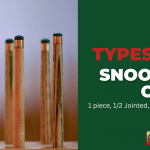For a new player, cue tips might not be a huge concern. However, you need to have the best snooker cue tips if you want the best play from your game. Professionals are also highly aware of how your cue tip might affect the accuracy of your shots when you hit the ball.
How to Choose a Snooker Cue Tip
Table of Contents
When choosing the snooker cue tips, there are various things that you need to consider. Before making a decision, you need to research carefully the tip’s material, hardness, consistency, and durability.
Hardness
Cue tip’s hardness is an important factor to consider while choosing cue tips. If you can’t decide on one while researching, then you can try them out and then decide. Many players acknowledge that they had to try several before deciding on one suiting their preference.
If your play style involves increased movement of the cue ball around the table, a soft tip will be preferable. A soft cue tip also performs better if your game involves a lot of spinning as it retains a lot of chalk. So, soft tips are a good option if you want the snooker cue tips for spin. However, they may require more shaping.
If you are a beginner and have no idea which suits your more, you can consider medium cue tips. With the medium tips, you can get some good cue ball spins. But they will pale in comparison to what you can get with a soft tip. Additionally, you can also save time on maintenance using a medium cue tip.
Hard cue tips as opposed to soft cue tips also don’t require much shaping. However, if you want to get a good spin with them, you’ll need to put more effort while chalking them. Otherwise, there are more chances to make mistakes since they absorb less energy at impact.
Durability
When cue tips start to deteriorate, they need to be changed. Serious players typically have them for six to twelve months. If the cue tip is thinner than 1mm or feels extremely smooth and flat, it needs to be replaced.
The majority of players will be able to tell when the cue tip needs to be replaced because this will also affect the shots. Though, changing the cue tips doesn’t bother the majority of professional players. They may have them changed periodically or after each game. The decision is entirely up to the player.
Size
This is another crucial factor to take into account when choosing the snooker cue tips. 9.5mm, 10mm, and 11mm are the most common cue tip sizes. The cue tip’s diameter has a significant impact on your play style.
Larger diameter pool cue tips assist beginning players in pocketing the balls more readily. Whereas, smaller diameter tips aid skilled players in adding an English side-spin to the cue ball.
For beginners, a large diameter of about 10 mm cue tips is typically advised. The large surface area of the cue tip makes it easier for new players to complete even the trickiest strokes. As your pool skills advance, you can utilize smaller cue tips and work on your side spin.
Consistency
Consistency is another one of the cue tip’s most crucial skills. For consistency, you have to try out different cue tips and then select whichever suits your play style. Professional athletes test out many cue tips until they find one with good consistency. Some players also believe that consistency depends more on a player’s skills than the cue tip they are using.
Shape
Cue tip shape is another matter that you have to consider while choosing the snooker cue tips. The main difference lies in the diameter of the cue tip. Each shape has a specific advantage over the other. One benefit of a flatter tip is that a center-ball hit with a slightly crooked tip placement will typically have fewer unexpected swerves and throws.
For near-center-ball hits, a broader, flatter tip is also more lenient with misalignment faults. Additionally, compared to a rounder tip, flatter tips can also control minor sidespins better. This is because a greater cue offset is needed to create more spin. However, a flatter tip will produce less sidespin when there are stroke faults and the cue is angled toward the bridge.
If the cue tip is shaped like a dime, the point of contact with the cue ball will be smaller. This will enable you to generate more spin and hence, are considered some of the snooker cue tips for spin. However, it requires more good control as otherwise, it would result in frequent errors.
As the tip offset is raised, a more uniform contact area is made possible by the rounder shape. For a rounder tip, the impact of spin shots is more evenly distributed throughout the cue’s center. Hence, some players prefer rounder tips with firm shots.
Additionally, the cue vibrations will be somewhat lesser because of the reduced offset from the cue’s center. This also results in the hit’s effectiveness being a little bit higher.
For beginner players, the nickel radius can be better. This is due to a greater point of contact with the cue ball resulting in easier control. The disadvantage of nickel radius is that it gives less spin.
You must exercise greater caution while selecting the cue tip that will best meet your needs. You can avoid these tips if you are looking for the best snooker cue tips for spin. So, take your time testing out the many choices until you find the best one for you.
Material
Solid leather and layered leather are the most frequently used cue tips. Solid leather cue tips are typically created by pressing a thick piece of leather into a single layer. This makes solid leather cue tips have better quality at reasonable prices. These cue tips are loved by a majority of beginner and intermediate-level players.
If you want some of the snooker cue tips, then solid leather cue tips are also a great option. They have a distinctive solid hit, particularly when hitting the cue ball. They also come in a variety of sizes, so you can select the one that suits your preferences. They also don’t need a lot of trimming, which makes them perfect for new players.
There are also some drawbacks to using solid leather cue tips. Consistency of these cue tips may also be a problem. There is a good chance that these cue tips will perform differently even while buying from the same manufacturer. These cue tips also have a tendency to compress quickly so they require more maintenance.
The layered cue tips are often referred to as laminated tips. They are comprised of multiple compacted layers of leather as opposed to solid leather tips. These layers are typically identical and come from the same leather portion. These cue tips are more durable due to their intricate and precise production procedure.
Layered cue tips provide players with a high level of consistency, making them perfect for professional players. Additionally, they retain chalk for a long time, improving consistency and cue ball control. They also maintain their shape better, requiring less maintenance. Layered cue tips are hence, more expensive than their solid leather counterparts.







